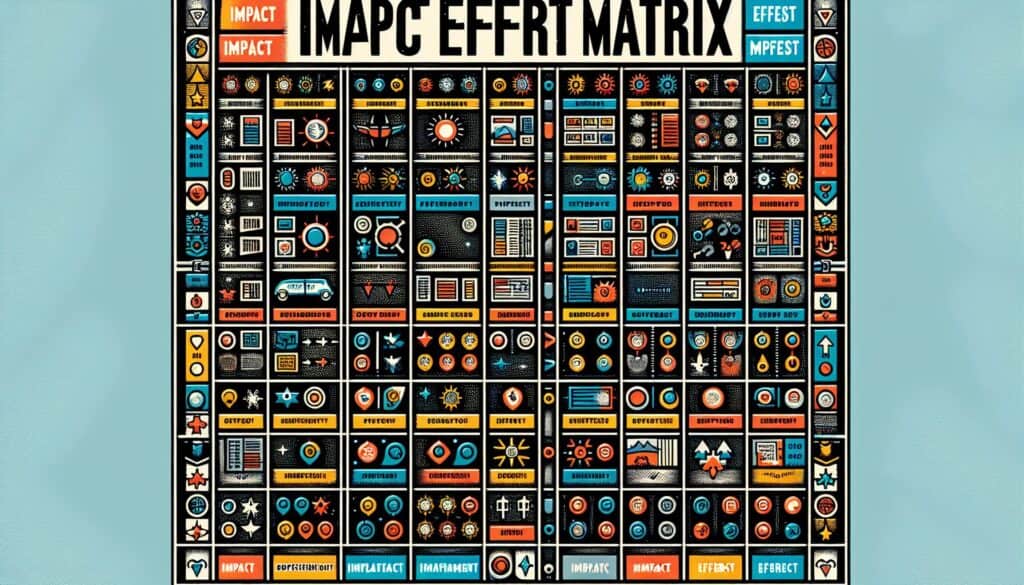Priorisierung von Aufgaben oder Initiativen auf der Grundlage ihrer potenziellen Auswirkungen und des zu ihrer Umsetzung erforderlichen Aufwands.
- Methodologien: Projektmanagement
Impact Effort Matrix

Impact Effort Matrix
- Agile Methodik, Kontinuierliche Verbesserung, Design Denken, Schlanke Fertigung, Projektmanagement, Qualitätsmanagement, Gedränge, Nachhaltigkeitspraktiken, Wertstrom-Mapping
Zielsetzung:
Wie es verwendet wird:
- Ein 2x2-Gitter, bei dem eine Achse die Auswirkungen (z. B. hoch/niedrig) und die andere den Aufwand (z. B. hoch/niedrig) darstellt. Die Elemente werden in die Matrix eingetragen, um Quick Wins (hohe Auswirkung, geringer Aufwand), Großprojekte (hohe Auswirkung, hoher Aufwand), Lückenfüller (geringe Auswirkung, geringer Aufwand) und undankbare Aufgaben (geringe Auswirkung, hoher Aufwand) zu identifizieren.
Vorteile
- Einfach und anschaulich; Erleichtert die schnelle Entscheidungsfindung und Prioritätensetzung; Hilft den Teams, sich auf die Aktivitäten mit dem höchsten Return on Investment zu konzentrieren; Fördert die Diskussion und den Konsens über Prioritäten.
Nachteile
- Subjektivität bei der Bewertung der Auswirkungen und des Aufwands; kann komplexe Entscheidungen zu sehr vereinfachen; berücksichtigt nicht die Abhängigkeiten zwischen Aufgaben oder die strategische Ausrichtung ohne zusätzlichen Kontext.
Kategorien:
- Ideenfindung, Problemlösung, Projektmanagement
Am besten geeignet für:
- Schnelles Setzen von Prioritäten in einer Liste von Ideen, Projekten oder Aufgaben, um festzustellen, worauf man sich zuerst konzentrieren sollte.
The Impact Effort Matrix is commonly employed in various industries including software development, product management, and engineering, particularly during the ideation and planning phases of projects. This methodology aids teams in evaluating potential initiatives by visualizing which tasks could lead to significant benefits with minimal resource investment, allowing for efficient allocation of efforts. In software development, for example, a team might identify user interface enhancements that could improve customer satisfaction significantly while requiring little coding effort, thus categorizing them as quick wins. Conversely, a manufacturing firm might plot a new product line launch that promises high returns but demands extensive R&D and market validation, positioning it within the major projects quadrant. Stakeholders from cross-functional teams, including marketing, design, and engineering, typically contribute to this exercise to leverage diverse insights and foster collective decision-making. The visual nature of the matrix facilitates discussions that can align team members on priorities, ultimately driving a consensus on which initiatives should receive immediate attention to maximize efficiency and effectiveness in project execution. This approach not only accelerates decision-making but also improves transparency in the prioritization process, ensuring that team efforts are concentrated where they can yield the most substantial impact.
Die wichtigsten Schritte dieser Methodik
- Define criteria for impact and effort based on project goals.
- List ideas, projects, or tasks that need prioritization.
- Assess and assign impact and effort scores to each item.
- Plot the items on the 2x2 grid based on their scores.
- Identify and categorize items in the quadrants: quick wins, major projects, fill-ins, and thankless tasks.
- Discuss and prioritize actions based on the visual representation of the grid.
- Determine next steps for implementing the prioritized items.
Profi-Tipps
- Incorporate stakeholder feedback in the matrix creation process to align project priorities with organizational goals.
- Regularly update the matrix as new data or insights emerge, ensuring that your prioritization reflects current market conditions and customer needs.
- Utilize color-coding or tagging on the matrix for different team members or departments to visually represent responsibility and improve collaborative discussions.
Verschiedene Methoden lesen und vergleichen, Wir empfehlen die
> Umfassendes Methoden-Repository <
zusammen mit den über 400 anderen Methoden.
Ihre Kommentare zu dieser Methodik oder zusätzliche Informationen sind willkommen auf der Kommentarbereich unten ↓ , sowie alle ingenieursbezogenen Ideen oder Links.
Historischer Kontext
1960
1980
1983
1990
1995
2000
2010
1950
1980
1980
1986
1994
1995
2000
(wenn das Datum nicht bekannt oder nicht relevant ist, z. B. "Strömungsmechanik", wird eine gerundete Schätzung des bemerkenswerten Erscheinens angegeben)














Verwandte Artikel
Fragebögen zu muskuloskelettalen Beschwerden
Multivariate Tests (MVT)
Mehrfache Regressionsanalyse
Motion-Capture-Systeme
MoSCoW-Methode
Moods Median-Test